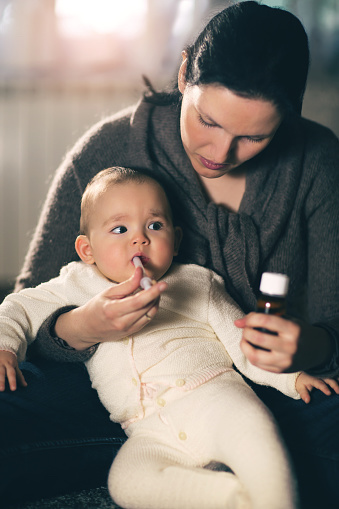What every parent should know about febrile seizures
What is a febrile seizure?
A seizure is abnormal electrical activity in the brain that causes abnormal movements or one to pass out. A febrile seizure is a seizure that occurs when a child has a fever of 100.4°F (38°C) or higher that is due to an infection not involving the brain or spinal cord. Febrile seizures usually occur in children ages 6 months to 5 years and are most common from 12 to 18 months old.
 It is important to remember that not all children with fevers have seizures. Research has shown that between 3% and 8% of children younger than 5 years will experience febrile seizures. There are certain risk factors that put children at risk to have a febrile seizure. However, half of children who have febrile seizures have no risk factors. The most common risk factors are high fever, viral infection, recent immunization, and a family history of febrile seizures. While febrile seizures can occur following certain immunizations, the risk is very small and the protection your child gets from those vaccines outweighs that risk.
It is important to remember that not all children with fevers have seizures. Research has shown that between 3% and 8% of children younger than 5 years will experience febrile seizures. There are certain risk factors that put children at risk to have a febrile seizure. However, half of children who have febrile seizures have no risk factors. The most common risk factors are high fever, viral infection, recent immunization, and a family history of febrile seizures. While febrile seizures can occur following certain immunizations, the risk is very small and the protection your child gets from those vaccines outweighs that risk.
During a febrile seizure, a child usually passes out and has jerking movements of the arms, legs, or face. Most febrile seizures do not last long and occur for 1 or 2 minutes. In some cases they may last longer than 15 minutes and require medications to stop them. However, this is less common. When a seizure ends a child may be tired or confused. After a longer seizure, a child can even have short-term weakness of his or her arm or leg, as well as tiredness and confusion.
How to keep a child safe during a seizure
If your child has a febrile seizure, it is important to keep them safe. During a seizure, you should put your child on his or her side, not put anything in your child's mouth or try to stop the jerking movements, and keep track of how long the seizure lasts. You should call an ambulance (911) if the seizure lasts for more than 5 minutes. Long seizures interfere with how well a child is breathing and for the child’s safety, paramedics, nurses, and/or doctors can give medications to stop the seizure as well as support his or her breathing.
After a febrile seizure, a child needs to see a doctor or nurse as soon as possible. Once the seizure has stopped, the fever can be treated with acetaminophen (Tylenol) or ibuprofen (Motrin, Advil). Often there is a viral infection (which generally needs to run its course), but your child needs to be checked for signs and symptoms of other treatable problems like ear infections and pneumonia, or more serious infections. Certain testing may need to be done to determine the infection.
For febrile seizures that stop on their own and have lasted less than 15 minutes, there is no treatment needed and children do not need to stay in the hospital. If the febrile seizure lasts longer than 15 minutes or your child has more than one seizure in a day, he or she will likely need to stay in the hospital for tests and/or medicines.
After a first febrile seizure, it is possible for children to have them in the future. In fact, research has shown that children who have had one febrile seizure have about 30% to 35% chance of having another. However, when a child is younger than 12 months at the time of the first febrile seizure, the risk can be up to 50%.
Can medicine help prevent febrile seizures?
 Fever-reducing medicines have not been found to prevent the reoccurrence of febrile seizures. A fever is a body’s response to infection and while fever-reducing medicines like acetaminophen (Tylenol) and ibuprofen (Motrin, Advil) will help bring down a fever, they will not treat an infection. Anti-seizure medicines used for the prevention of febrile seizures can decrease the risk of recurrent febrile seizures, but these medications can have serious side effects. Since most febrile seizures are not harmful, the risks of side effects generally outweigh the benefits of using the mediations.
Fever-reducing medicines have not been found to prevent the reoccurrence of febrile seizures. A fever is a body’s response to infection and while fever-reducing medicines like acetaminophen (Tylenol) and ibuprofen (Motrin, Advil) will help bring down a fever, they will not treat an infection. Anti-seizure medicines used for the prevention of febrile seizures can decrease the risk of recurrent febrile seizures, but these medications can have serious side effects. Since most febrile seizures are not harmful, the risks of side effects generally outweigh the benefits of using the mediations.
While febrile seizures are frightening to watch, they are unlikely to cause lasting harm. Intelligence and other aspects of brain development do not appear to be affected by a febrile seizure, and having a febrile seizure does not mean that a child has epilepsy, a life-long seizure condition. However, a febrile seizure may be the first sign of a seizure disorder which is another reason why a child who has a febrile seizure should be seen regularly by a pediatrician.
For more information, talk to your child’s pediatrician. You can also learn more about febrile seizures here: healthychildren.org.






